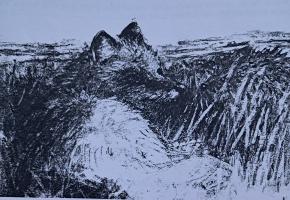Youthnet NEWS Issue 11

Youthnet NEWS 011 11/3/94
Alexis Leynes N9KYJ
Jennie Finch N9SAK
Topic:
- Fox hunting
Fox hunting
There are many aspects of amateur radio that many hams don't understand very well. In this edition we will cover fox hunting. If you do not know what fox hunting is, it is considered an exercise of locating a hidden transmitter by usage of triangulation. In simpler terms Fox hunting doesn't involve a real fox. Fox hunting is about hiding a transmitter and then have a group of other hams to look for the transmitter. Usually the group who looks for the transmitter generally are called the hunter(s). These groups of one or two in a team (maybe more or less in some areas), may use very complex directional finding equipment or even very simple equipment.
You may be wondering why hams go on fox hunts. Fox hunting is an exercise like Field day. The main purpose of it is to train ham operators or how to locate a transmitter of any type efficiently. Sometimes, hams help the local authorities search for downed aircraft, lost boats, or even lost campers. Fox hunters also search for possible sources of interference on a repeater, beacon, or on frequency. Fox hunters are an important aspect to amateur radio.
There are many ways to track down a transmitter. Equipment can be just a simple HT and a beam antenna or a doppler directional system (It is an automatic pointer, which shows the hunter the general direction of the fox). The hunters usually begin at a starting point a few miles away from the actual transmitter. The fox then transmits for one minute and then turns the transmitter off for 5 to 10 minutes and transmits again for one minute. Rules vary to from group to group. Some fox hunting groups requires the fox to transmit for 2 minutes every 30 minutes, but they have the option to have anyone to ask the fox to retransmit (with a penalty of a point deduction, whenever a group asks). Again rules vary from group to group.
Now that I explained the basics of fox hunting, I'm going to focus on the fox. A few months ago, I had the pleasure of being the fox with another fellow ham, Mike WA9FTS. It was their monthly 146.45 hunt. Being the fox may be fun. You get to hide almost anywhere. You can make the transmitter small or large. To hide a transmitter in a small location, one can use a dual band HT which can automatically retransmit a signal heard on another frequency. On this hunt, Mike and I used a mobile Kenwood radio, with a motorcycle battery, and a J-pole, hid in a field with weeds all around us, a creek that was near, and a fence which almost incased us. To top it off, we hid ourselves underneath some military camouflage, which helped us blend into the environment. Our setup was so good, that one of the fox hunters just passed by only 10 feet away. This hunt lasted for an hour and a half. It was a great location, and I think almost everyone had a wet shoe or two when they went over the creek.
There are a few important considerations to be a fox. One, accessibility; it is not a good idea to hide on private property, or to hide in a place which is impossible to get to. Two, dangerous surroundings; it is not a good idea to hide in or near a place which may bring danger to you, the hunters, or the people who are nearby. Three, when you transmit, always address one of the hunters by calling their callsign. Failure to do so would be considered broadcasting. Four, notification. Notify the local authorities on what you and your group are going to do. This will tell them what is going on, if in case someone calls them up, saying that someone weird is walking up and down their street with a funny antenna (believe me, it happens). Five, if this going to be a driving fox hunt, make sure that there is a place for the hunters to park their cars legally. Fox hunting may be fun if it is done right, and safely.
Now that you know some of the basic rules and guidelines of the hunt, I'll tell you what it is like being the hunter. Last Saturday night, Mike and I went out to a fox hunt here in the Chicagoland area, and we ended up second. We used what Mike called a "L-PER" (It was like a beam antenna that is specialized in a way that it would point the hunter in the right direction). Aside from a good tracking system, you may need a few more things. Here are a few things that I would recommend to bring on a hunt. Flashlights, over here, the hunts starts after sundown and it gets very dark. Maps, preferably a laminated covered one that you can use a marker on and use over and over again. A ruler to plot a line from your location. Insect repellant lotion (self explanatory). Long clothing, in case the fox hides in a weeded field. A first aid kit, in case you or someone else cuts themselves in the weeded field. And the most important factor, luck, fox hunts are not always perfect. For instance, there was another group who arrived 30 seconds before us, and lucky for us, their door was stuck shut, giving us a few minutes to grab second place.
Everyone has their own methods in looking for the fox. Some hunters stop the car, and look for the position; while others search, triangulate, navigate and drive at the same time. One more thing, when you are on a hunt, time flies very quickly, and hours pass without notice.
It is hard to describe the feeling you get on a hunt. My suggestion is to find a local group and ride along with them. Over here in Chicago, the group I am with has a fox hunt almost every Saturday. So ask around and tell us at Youthnet NEWS about your fox hunting experience.
For more information on fox hunting, go to your local library and read Transmitter Hunting: Radio Directional Finding Simplified, by Joseph D. Moell, K0OV, and Thomas N. Curlee, or Homing in by 73 Amateur Radio Today written also by Joseph D. Moell.
Special thanks go to Mike, WA9FTS, Art, WB9JIT, Mike, KB9ISW, and Nila, KB9ITR.
73's DE Alex & Jennie
E-mail: aln9kyj@mcs.com
Packet: N9KYJ@W9ZMR.IL.USA.NOAM
N9SAK@WB2WXQ.#WNY.NY.USA.NA
Youthnet NEWS is an amateur radio informational service for the young radio amateur operator. All Rights are reserved 1994.























